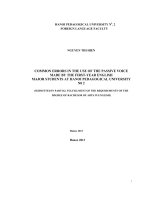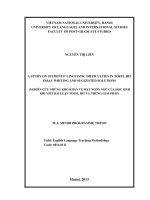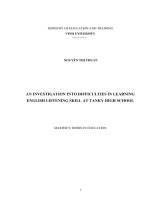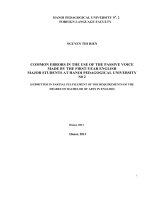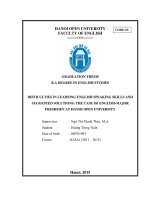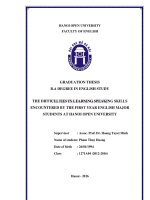Difficulties in learning english speaking skills and suggested solutions the case of english major freshment at hanoi open university
Bạn đang xem bản rút gọn của tài liệu. Xem và tải ngay bản đầy đủ của tài liệu tại đây (1.57 MB, 55 trang )
HANOI OPEN UNIVERSITY
FACULTY OF ENGLISH
CODE: 09
======o0o======
GRADUATION THESIS
B.A DEGREE IN ENGLISH STUDIES
DIFFICULTIES IN LEARNING ENGLISH SPEAKING SKILLS AND
SUGGESTED SOLUTIONS: THE CASE OF ENGLISH-MAJOR
FRESHMEN AT HANOI OPEN UNIVERSITY
Supervisor
: Ngô Thị Thanh Thảo, M.A.
Student
: Hoàng Trọng Tuấn
Date of birth
: 10/03/1993
Course
: K18A1 (2011 – 2015)
Hanoi, 2015
DECLARATION
I declare that this thesis with the title “Difficulties in learning English
speaking skills and suggested solutions: The case of English-major freshmen at
Hanoi Open University” and the work presented in it is my own and has been
generated by me as the result of my own original research.
I confirm that when I quoted from the work of others, the source was
always given. No part of this work has been published before submission.
Hanoi, 28 May, 2015
Student’s signature
Supervisor’s signature
ACKNOWLEDGEMENTS
First and foremost, I would like to express my great gratitude to my
supervisor, Mrs Ngô Thị Thanh Thảo, M.A, for her enthusiasm, kindness and
helpful advice which encourages me much during my time of implementing the
thesis.
Special thanks also go to all teachers, who have been teaching for many
years at the Faculty of English, Hanoi Open University, always try to impart
their knowledge and experience to the students and that cannot be expressed in
words.
I wish to acknowledge the kind help of the first year language students at
Faculty of English, Hanoi Open University, who helped me to collect data, and
their valuable support for finishing the study.
Finally and most importantly, I would like to express my whole-hearted
gratitude to my family. I could not have come this far without their spiritual
encouragement.
Hanoi, 2015
Hoàng Trọng Tuấn
TABLE OF CONTENTS
DECLARATION
ACKNOWLEDGEMENTS
TABLE OF CONTENTS
PART A: INTRODUCTION
I.Rationale……………………..............……………………………..………………….1
II. Aims of the study ................................................................................................ 2
III. Scope of the study ............................................................................................. 2
V. Methods of the study .......................................................................................... 2
VI. Design of the study……………………………………………………………..……5
PART B: THE DEVELOPMENT
CHAPTER I: LITERATURE REVIEW
1.1. Communication ........................................................................................... 4
1.1.1. The definition of communication ........................................................... 4
1.1.2. The communication process .................................................................. 9
1.2. Kinds of Communication .......................................................................... 11
1.2.1. Verbal communication ........................................................................ 11
1.2.2. Nonverbal communication .................................................................. 12
1.3. Speaking skill ............................................................................................ 14
1.3.1. The definition of speaking skill ........................................................... 14
1.3.2. The role of speaking ........................................................................... 15
1.3.3. Characteristics of speaking ................................................................. 16
1.4. Problems with speaking and speaking activities…………………………. 18
1.4.1. Problems with speaking…………………………………………………..18
1.4.2. Problems with speaking activities ...................................................... 19
CHAPTER 2 : THE STUDY ON LEARNING ENGLISH SPEAKING
SKILLS AT FACULTY OF ENGLISH - HANOI OPEN UNIVERSITY
2.1. Practical situation of learning speaking skills at Faculty of English .... 21
2.1.1. Description of the freshmen‟s curriculum of Faculty of English ........ 21
2.1.2. Description of the freshmen at Faculty of English ............................. 22
2.2. The study…………………..………………………………………………….23
2.2.1. Participants.......................................................................................... 23
2.2.2. The data collection mehods…………………………………………. 23
2.2.3. Data analysis of the first year students's survey questionnaires……..24
2.3.Summary……………………………………………………………....…31
CHAPTER 3: SOME SUGGESTED TECHNIQUES IN LEARNING
ENGLISH SPEAKING FOR THE FIRST YEAR ENGLISH MAJORS AT
HANOI OPEN UNIVERSITY
3.1. Easy ways to extent English vocabulary and improve the pronunciation
and intonation .................................................................................................. 32
3.1.1. Repeat and Re-phrase ......................................................................... 32
3.1.2. Music and Songs.................................................................................. 33
3.1.3. Audio-Recorder ................................................................................... 34
3.1.4. TV and Video ....................................................................................... 34
3.1.5. Visual Aides, Maps, Pictures and Multimedia .................................... 35
3.2. Broaden the socio-cultural knowledge through English reading .......... 36
3.3. Build an English speaking environment efficiently ................................ 36
3.3.1. Re-arrange tables and decorate classroom ........................................ 36
3.3.2. Cooperate Groups and Peer Coaching ............................................... 37
3.3.3. Simulation............................................................................................ 38
3.3.4. Become more self-confident by role-play method ............................... 39
3.3.5. Games .................................................................................................. 40
3.4. Summary ......................................................... Error! Bookmark not defined.
PART C: CONCLUSION……..……………………….……………………...47
LIST OF REFERENCES ……………………….………………………….. .48
APPENDIX
PART A: INTRODUCTION
The current study begins with this introductory part, which describes
the rationale of the study and presents the aims of the study. It also discusses
the scope of the study, the method of the study and provides the design of
the study.
I. Rationale of the study
Since the open-door policy adapted to Vietnam, the need for integrating
into the world has increased. That is the reason why English learning has become
very important to our country’s modernization and industrialization.
Nowadays, learning English plays a much more important role in
international interaction than ever before. In a modern world, to adapt to this
global village, the ability of communicating fluently in English is very
important. However, learning speaking English in Vietnam has been strongly
influenced by the traditional methods, even in top universities and colleges.
Students pay too much attention to the grammatical items. Many teachers mainly
focused on explaining the grammatical rules and structures to students who were
considered as passive recipients. As a result, a great number of students might be
structurally competent but communicatively incompetent. That causes a lot of
difficulties in using English in their real-life communication.
At the beginning of getting into Hanoi Open University, the writer faced
many difficulties learning English speaking skills. As an English major student,
the writer realizes how English learners try their best to reach their goals to study
speaking skills effectively, but up to now the results have been still far from
satisfaction. Hence, the author would like to do a research with a hope to
improve speaking skills for English major freshmen. The research entitled
1
“Difficulties in learning English speaking skills and suggested solutions: The
case of English-major freshmen at Hanoi Open University”.
II. Aims of the study
The study is an attempt to:
Investigate the attitudes of the freshmen at Faculty of English, Hanoi Open
University towards the importance of speaking skills.
Discover the common obstacles preventing the English major freshmen
from willingly taking part in speaking activities at the English class.
Make some recommendations for the English major freshmen to consult
and apply in their learning speaking skills so that they could improve their
speaking competence.
III. Scope of the study
The study was implemented with the participation of 200 first year
students who are studying full-time at the Faculty of English, Hanoi Open
University. The writer only focuses on finding out the reality of learning English
speaking to the first year English-major students. Although the author is well
aware that the survey statistics are not fully representative of all the English
major students at many universities in Vietnam, the researcher hopes to propose
some of the most popular facts that occurring in the study.
IV. Method of the study
Firstly, questionnaires are delivered to the students of K21 who are
learning at Faculty of English (HOU) so that more information on the reality and
problems they face in learning speaking skills and solutions implemented can be
collected. The information from questionnaires can help to draw a general
2
picture about the reality of learning speaking skills at Faculty of English, HOU
and suggest some solutions for this situation.
All comments, remarks, recommendations, and conclusions provided in
the study will be based on the data analysis.
V. Design of the study
This study is going to be divided into three parts, as follows:
Part A, Introduction, which presents the rationales, the objectives, the method
and the design of the study. It expresses the reason why the author decided to
choose this study and the methods for the fulfillment of the study.
Part B, Development, consists of the three following chapters:
Chapter 1 is intended to give some theoretical background related to
communication, kinds of communication, the definition and the role of English
speaking skill, the characteristics of speaking skill as well as some problems
with speaking and speaking activities. Chapter 2 provides an analysis on the
practical situation of learning English speaking skills at Faculty of English (HOU),
the attitudes of English major freshmen towards speaking skills. Also, the current
learning of speaking skills accompanied by difficulties of first year students of
Faculty of English (HOU) will be discussed. Information about students, current
methods, materials and problems, is mentioned. Chapter 3 focuses on
recommendations about using some activities to get over difficulties and
improving speaking skills.
Part C, Conclusion, addresses the key issues in the study, summarizing some
shortcomings revealed during the process of completing this research paper.
3
PART B: THE DEVELOPMENT
CHAPTER 1: LITERATURE REVIEW
This chapter will focus on the theoretical background of speaking which is
of great importance to study. It has contribution to any part of following sections
in order to make it clear in the fields of speaking.
1.1. Communication
1.1.1. The definitions of communication
Whenever we participate in talking and exchanging activities in daily life,
we perform the communicative activities.
According to the explanation of Wood (1992), “You spend more time than
doing anything else. We talk, listen, think, share, confidences with intimates,
ask, and answer questions, participate on teams, attend public presentations,
watch television programs, and so forth. From birth to death communication is
the central to our personal, professional and cultural lives.
The word “communication” may be understood in many ways depending on
different goals. So the definition of communication ranges widely. Here are
some points of view: “Communication is defined as a process by which
information is exchanged between individuals through a common system of
symbols, signs, or behavior”.
Communication is a process that allows organisms to exchange information
by several methods. Exchange requires feedback. The word “communication is
also used in the context where little or no feedback is expected such as
broadcasting, or where the feedback may be delayed as the sender or receiver use
different methods, technologies, timing and means for feedback.
4
Communication is the articulation of sending a message, whether it is
verbal or nonverbal, so long as to produce understanding.
Communication is the process by which any message is given or received
through talking, writing, or making gestures. There are auditory means, such as
speaking, singing, and sometimes tone of voice, and nonverbal, physical means,
such as body language, sign language, paralanguage, touch, eye touch, or the use
of writing.
According to Susan Stokes, communication is a range of purposeful
behavior which is used with intent the structure of social exchanges, to transmit
information, observations, or internal states, or to bring about changes in the
immediate environment. Verbal as well as nonverbal behaviors are included, as
long as some intent, evidenced by anticipation of outcome can be inferred.
Therefore not all vocalization, or even speech, can qualify as intentional
communicative behavior.
These point of views only a small number lying in the various number of
communication definitions. Because it is complex, communication is difficult to
define. The word “communication” is abstract and like all words, possesses
multiple
meanings.
Scholars
have
made
many
attempts
to
define
“communication”, but seeking a single definition may not be as fruitful as
looking at the various concepts behind the term. The term “communication” can
be used in a number of ways. Frank Dance took a major step toward clarifying
this muddy concept by outlining fifteen distinct conceptual components in the
various definitions. He used these components as the basic ideas to distinguish
communication from other things. According to Frank E. X. Dance, “The
Concept of Communication,” Journal of Communication, 20, 1970, p. 201-210:
5
“Communication is the verbal interchange of thought or idea.” John
1.
B.Hoben, “English Communication at Colgate Re-Examined”.
Journal of Communication 4: 76-86, p. 77.
“Communication is the process by which we understand others and in
2.
turn endeavor to be
understood by them. It is dynamic, constantly
changing and shifting in response to the total situation.” Martin
Andersen. “What is Communication?”
“Interaction, even on the biological level, is a kind of communication;
otherwise
3.
common
acts
could
not
occur.” George
Herbert
Mead. “Mind, Self, and Society.” In Sociology, 3rd ed. (Edited by
Leonard Broom and Philip Selznik). New York: Harper and Row, 1963.
“Communication arises out of the need to reduce uncertainty, to act
effectively,
4.
to
defend
Barnlund. “Toward
a
or
strengthen
the
Meaning-Centered
ego.” Dean
C.
Philosophy
of
Communication.” Journal of Communication 12: 197-211, 1964,
“Communication: the transmission of information, ideas, emotions,
skills, etc., by the use of symbols—words, pictures, figures, graphs,
5.
etc. It is the act or process of transmission that is usually called
communication.” In Bernard Berelson and Gary A. Steiner. Human
Behavior. New York: Harcourt, Brace and World, 1964, p. 254.
6
“… The connecting thread appears to be the idea of something‟s being
transferred from one thing, or person, to another. We use the word
“communication” sometimes to refer to what is so transferred,
sometimes to the means, by which it is transferred, sometimes to the
whole process. In many cases, what is transferred in this way
continues to be shared; if I convey information to another person, it
6
does
not
leave
my
own
possession
through
coming
into
his. Accordingly, the word “communication” acquires also the sense
of participation. It is in this sense, for example, that religious
worshippers are said to communicate.” A.J. Ayer “What is
Communication?” In Studies in Communication. Communication
Research Centre, University College, London: Martin Sacker and
Warburg, 1955, 11-28, p. 12.
“Communication is the process that links discontinuous parts of the
7.
living world to one another.” Jurgen Ruesch. „Technology and Social
Communication.” In Communication Theory and Research (Edited by
Lee Thayer). Springfield, III.” Charles C. Thomas, 1957.
“It (communication) is a process that makes common to two or several
8.
what was the monopoly of one or some.” Alex Gode. “What is
Communication?” Journal of Communication 9:5, 1959.
7
“(pl.) …the means of sending military messages, orders, etc., as by
telephone,telegraph,radio,
9.
couriers.” The American College Dictionary. New
York:
Random
House, 1964, p. 244.
“Communication is the process of conducting the attention of another
person for the purpose of replicating memories.” F.A. Cartier and
10.
F.A. Harwood. “On Definition of Communication.” Journal of
Communication 3:71-75, 1953, p. 73.
“Communication is the discriminatory response of an organism to a
stimulus.” S. S. Stevens. “A Definition of Communication.” Journal of
the Acoustical Society of America 22: 689-90, 1950, p. 689. “So,
communication between two animals is said to occur when one animal
11.
produces a chemical or physical change in the environment (signs that
influences the behavior of another…” Hubert Frings. “Animal
Communication in Communication: Concepts and Perspectives (Edited
by Lee Thayer), Wash., D.C.: Spartan Books, 1967, 297-329, p. 297.
Every communication act is viewed as a transmission of information,
consisting of discriminative stimuli, from a source to a recipient.”
12.
Theodore M. Newcomb, „An Approach to the Study of Communication
Acts. In Communication and Culture(Edited by Alfred G. Smith). New
York: Holt, Rinehart and Winston, 1966, 66-79, p. 66
8
“In the main, communication has as its central interest those
behavioral situations in which a source transmits a message to a
13.
receiver(s) with
conscious
intent
to
affect
the
latter‟s
behaviors.” Gerald A. Miller, “On Defining Communication: Another
Stab.” In Journal of Communication 16:88-98, 1966, p. 92.
“The communication process is one of transition from one structured
situation-as-a-whole to another, in preferred design.” Bess Sondel,
14.
“Toward a Field Theory of Communication.” In Journal of
Communication 6:147-53, 1956, p. 148.
“…communication is the mechanism by which power is exerted.” S.
15.
Schacter. “Deviation, Rejection, and Communication.” In Journal
of Abnormal and Social Psychology 46-190-207, 1951 p. 191.
1.1.2 The communication process
9
Sender
The sender needs to be clear about what to communicate and also needs to
be confident that the information is useful and accurate. Shortly, the sender has
an intention to communicate with other person. This intention will makes up the
content of the massage.
Message
The message is the information that the sender wants to communicate.
Encoding
Encoding is the process of transferring the information the sender wants to
communicate into a form that can be sent and decoded correctly.
Channel
Message is conveyed through channel which can be made of a variety of
materials, including verbal communication and written communication.
Decoding
Decoding in the process of restoring original messages from the forms in
which they were transmitted, stored and enciphered by applying a suitable
code.
Receiver
The message is delivered to the listeners who are receivers.
Feedback
The receiver will provide the sender with feedback, verbal and nonverbal
reactions to the communicated massage.
Context
The context is the situation in which the massage is delivered
10
That is the communication process in detail. However, we also can
understand the process in brief by the way as follow:
• Thought: First, information exists in the mind of sender. This can be a
concept, idea, information that he or she can understand.
• Encoding: Next, a message is sent to a receiver in words or other symbols.
• Decoding: Lastly, the receiver translates the word or symbols into a
concept or information that he or she can understand.
1.2. Kinds of Communication
1.2.1. Verbal communication
The basis of communication is the interaction between people. Verbal
communication is one way for people to communicate face-to-face. Some of the
key components of verbal communication are sound, words, speaking, and
language.
At birth, most people have vocal cords, which produce sounds. Some words
may be imitative of natural sounds, but others may come from expressions of
emotion, such as laughter or crying. Words alone have no meaning. Only people
can put meaning into words. As meaning is assigned to words, language
develops, which leads to the development of speaking.
The actual origin of language is subject to considerable speculation. Some
theorists believe it is an outgrowth of group activities such as working together
or dancing. Others believe that language developed from basic sounds and
gestures.
Over 3,000 languages and major dialects are spoken in the world today. The
development of languages reflects class, gender, profession, age group and other
social factors. The huge variety of languages usually creates difficulties between
11
different languages, but even within a single language there can be many
problems in understanding.
Through speaking we try to eliminate this misunderstanding, but sometimes
this is very hard thing to do. Just as we assume that our messages are clearly
received, so we assume that because something is important to us, it is important
to others. Many problems can arise is speaking and the only way to solve these
problems is through experience.
Speaking can be looked at in two major areas: interpersonal and public
speaking. Since the majority of speaking is an interpersonal process, to
communicate effectively we must not simply clean up our language, but learn to
relate to people.
In interpersonal speaking, etiquette is very important. To be an effective
communicator, one must speak in a manner that is not offending to the receiver.
Etiquette also plays an important role in an area that has developed in most all
business settings: hierarchical communication. In business today, hierarchical
communication is of utmost importance to all members involved.
The other major area of speaking is public speaking. From the origin of
time, it has been obvious that some people are just better public speakers than
others. Because of this, today a good speaker can earn a living by speaking to
people in a public setting. Some of the major areas of public speaking are
speaking to persuade, speaking to inform, and speaking to inspire or motivate.
1.2.2 Nonverbal communication
Even the best verbal communication skills are not enough to create and
sustain successful relationships. Good home and work relationships require the
ability to communicate emotions without saying a word.
12
Nonverbal communication, wordless communication conveyed through
facial expressions, body language, pace, intensity and tone of voice captures are
holds the attention of others and gives you a powerful means for self expression.
Nonverbal communication speaks louder than words. It takes more than
words to create productivity, safe, exciting and secure relationships. It takes the
ability to accurately pick up and send nonverbal cues that abstract and hold the
attention of others. Too often the signals we send are not those we intend to
send. When this happens, both connection and trust are lost in our relationships.
Nonverbal communication can be expressed love, suspicion, interest, anger, and
hatred. Physical object can symbolize professional identity, personal
commitment, and lifestyles.
Nonverbal communication is a perceptive and fresh aspect of the complex
communication system that causes many debates including both positive and
negative response. For the most part of the history of the study of the human
communication, the nonverbal element seems to be appropriately concerned.
Nonverbal communication is complex process involving people, words, and tone
of voice and body movements. However, Woods (1992) defines nonverbal
communication as a major dimension of human communication. It includes all
aspects of communication other than words. In addition to gestures, and body
language, nonverbal communication includes how people utter words, features of
environments that affect meaning.
In conclusion, form the above-mentioned points of views, we could
understand about the complex notions of communication.
13
1.3. Speaking skill
1.3.1. Definitions of speaking skill
Brown (1994); Burn and Joyce (1997) define speaking as follow:
Speaking is an interactive process of constructing meaning that involved
producing and receiving and processing information. Its form and meaning are
dependent on the context in which it occurs, including the participants
themselves, their collective experience, the physical environment and proposes
for speaking.
Speaking is considered as a skill because it needs to be learned, practiced
and developed. There are some definitions help us understand more about this.
According to Cheung (1994), “Speaking skill is the ability to use oral language
appropriately and effectively in learning activities within the classroom and in
social interactions within the school.”
In addition, there are two simple definitions is given in Webster’s Revised
Unabridged Dictionary (1913). The first is that “Speaking is the utterance of
intelligible speech.” The other shows that “Speaking is the delivering an address
to public audience.”
According to Wc Donough and Shaw: “Speaking is a skill which enables us
to produce utterances. When genuinely communicative, speaking is desire and
purpose-driven”. From this definition, we can understand that we genuinely want
to communicate with the hope to achieve a particular end. When speaking, we
hope to express ideas and opinions, express a wish or a dire to do something,
negotiate and solve a particular problem: or establish and maintain social
relationships and friendships.
14
From these definitions, we can realize that speaking activities happened
when we have exact goals. There are three kinds of speaking situations in which
we find ourselves:
- Interactive: Interactive speaking situations include face-to-face conversations
and telephone calls, in which we are alternately listening and speaking, and in
which we have a chance to ask for clarification, repetition, or slower speech from
our conversation partner.
- Partially interactive: Some speaking situations are partially interactive, such as
when giving a speech to a live audience, where the convention is that the
audience does not interrupt the speech. The speaker nevertheless can see the
audience and judge from the expressions on their faces and body language
whether or not he or she is being understood.
- Non interactive: Some few speaking situations may be totally non-interactive,
such as when recording a speech for a radio broadcast.
1.3.2 The role of speaking
Speaking not only directly helps us to communicate, but also supports other
three language skills: listening, reading and writing because it is used in
coordination with them. All these skills cannot be formed without another. This
is a strict relationship among them and these skills always have interactive
impact.
Speaking skill is built up on the grammar, vocabulary, structures and so on.
These factors provide learners a steady basic to develop speaking skill. Namely,
when speaking, you are able to reinforce grammar, remember new words and
apply the structures have learnt into real situation.
15
Traditionally, you will speak with other people, so you also can improve
your listening skill. As I have referred to above, speaking is an interactive
process of constructing meaning that involved producing and receiving and
processing information. So speaking coupled with listening. Moreover, these two
skills have close relation than other because they belong to oral communication
which is important in learning language. And the convenient thing is that you
can practice both at the same time.
Thanks to writing, learners can speak English accurately because they have
already experienced in using right structures and sentences. Writing is one of the
steps supporting for the process of speaking.
If you are good at reading, you will naturally enlarge your vocabulary so
much. This will bring speaking many benefits. The more you read, the better
your speaking will become. Because through reading you is not only provided a
large vocabulary, but also get background knowledge in many fields of life such
as: society, technology, politics, and so on.
In conclusion, these four skills cannot be learned separately. One skill can
make the others improved and be improved by others skills.
1.3.3. Characteristics of Speaking
As for Bygate M. (1987:12), in most speaking the person to whom we are
speaking is in front of us and able to put right if we make mistakes. He/ She can
also generally show agreement and understanding - or incomprehension and
disagreement. Unlike readers or writers, speakers may need patience and
imagination, too. While talking, speakers need to take notice of the other and
allows listeners chance to speak it. It means that we take turns to speak. Brown
(1983) and her colleagues point out that a listener helps speakers improve their
16
performance as a speaker because being a listener gives learner models to utilize
when acting as a speaker. In addition, being a hearer first helps the learner
appreciate the difficulties inherent in the task. It is clear that giving speakers
experience in hearer’s role is more helpful than simple practice in task in which a
speaker is having real difficulties in appreciating what a particular task required.
Speaking has the following characteristics:
Its form and meaning are dependent on the context in which it occurs,
including the participants themselves, their collective experiences, the physical
environment, and the purposes for speaking. It is often spontaneous, open-ended,
and evolving. However, speech is not always unpredictable. Language functions
(or patterns) that tend to recur in certain discourse situations can be identified
and charted.
Speaking requires that learners not only know how to produce specific
points of language such as grammar, pronunciation, or vocabulary (linguistic
competence), but also that they understand when, why, and in what ways to
produce language (“sociolinguistic competence”).
Speech has its own skills, structures, and conventions different from
written language. A good speaker synthesizes this array of skills and knowledge
to succeed in a given speech act.
Bygate (1987) considers speaking as an undervalued skill in many ways.
The reason is that almost all people can speak, and so take speaking skill too
much for granted. He also asserts that speaking skill deserves attention every bit
as much as literacy skilled. Learners often need to be able to speak with
confidence in order to carry out many of their most basic transactions. Bygate
17
also highly appreciates speaking by stating that speaking is the medium through
which much language is learnt.
To sum up, it is undeniable that speaking is the key to communication. By
considering what good speakers do, what speaking tasks can be used in class,
and what specific needs learners report, teachers can help learners improve their
speaking and overall oral competency.
1.4. Problems with Speaking and Speaking Activities
1.4.1. Problems with Speaking
Brown (1994:256) points out the characteristics of spoken language that
make speaking skills difficult as follows:
- Clusterings: In order to speak fluently, speakers have to select from their store
of language clusterings, which is groups of words, not word by word.
- Reduced forms: Contractions, elisions, reduced vowels, etc. create difficulties
in teaching and learning spoken English. If learners do not learn colloquial
contractions, they can develop the kind of speaking that is stilted, bookish.
- Colloquial language: Colloquialism appears both in monologues and dialogues.
If learners are only exposed to Standard English and/or “textbook” language,
they sometimes find it hard to understand and produce words, idioms and
phrases of colloquial language.
- Stress, rhyme and intonation: Learners of English often find it difficult to
pronounce English words, to stress the right syllables, to follow the stress-times
rhythm and intonation patterns of spoken English.
- Affective factors: Learners learning to speak often encounter the risk of saying
out things that may be wrong, stupid and incomprehensible. At those times, they
tend to be anxious because they do not want to be judged by other learners.
18
- Interaction: The greatest difficulty that learners face in learning to speak
originates from the interactive natural of most communication. Engages in
process of negotiation of meaning with many discourse constraints, learners have
to do the complex task of choosing what to say, how to say, when to speak, etc.
Learners are affected by their interlocutors’ performance.
1.4.2. Problems with Speaking Activities
Classroom activities that develop learners’ ability to express themselves
through speech are an important component of a language course. However, it is
more difficult to design and administer such activities than to do so for listening,
reading or writing. Teachers often come across the problems that Ur (1996:121)
lists out:
* Worries: Unlike reading, writing or listening activities speaking requires some
degree of real-time exposure to an audience. The student speaker has to face the
teacher and other students in class. Learners are often worried about trying to
says something in a foreign language in the classroom because they are worried
about making mistakes, afraid of criticism or losing face, or simply shy of the
attention that their speech attracts.
* Nothing to say: Teachers often hear learners; even if they are not worried or
nervous, complain that they cannot have anything to say. They may have no
motivated to express themselves beyond the guilty feeling that they should
speak. When they say something in class, they feel that they are forced to say.
* Uneven or low participation: Usually, there are many students in one class
(between 25 and 35 students). Only one student can talk at a time in a large
group. This means that each one have only very little time for talking. This
problem is compounded by the tendency of some learners to dominate the group,
19

